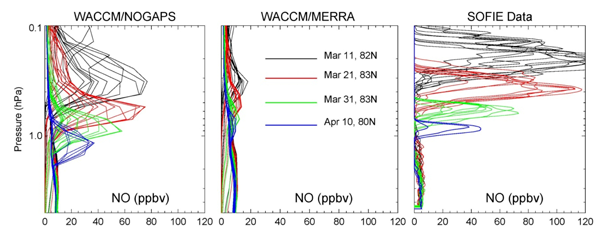|
STATUS:
07.29.2016
Instrument Status:
The AIM spacecraft continues to perform well.
SOFIE:
The SOFIE instrument continues to operate normally. As the orbit changes, SOFIE has viewed the 2015-16 Southern summer at latitudes near 32°S, and the 2016 Northern summer at latitudes near 35°N. The observations did not indicate PMCs at these latitudes, but are providing high precision measurements of a variety of parameters including meteoric smoke, gravity waves, and nitric oxide.
SOFIE observations were recently used in a study of thermosphere - stratosphere coupling by Siskind et al. [2015]. This paper investigated the descent of nitric oxide (NO) into the mesosphere and stratosphere, using SOFIE observations and two versions of the specified dynamics Whole Atmosphere Community Climate Model (WACCM) model. WACCM incorporated observations through analysis from either the Modern Era Retrospective Analysis for Research and Applications (MERRA) assimilation model which extends from 0-50 km, or the Navy Operational Global Atmospheric Prediction System- Advanced Level Physics High Altitude (NOGAPS-ALPHA) assimilation model which extends up to 92 km. The WACCM/NOGAPS model yields a much better representation of the observed NO descent than WACCM/MERRA. This is illustrated in the Figure below, which shows NO profiles for dates as labeled, from WACCM/NOGAPS (left), WACCM/MERRA (center), and SOFIE (right). The results of Siskind et al. [2015] indicate the importance of high-altitude meteorological analysis, and it is suggested that constraining WACCM to NOGAPS compensates for an underestimate of non-orographic gravity wave drag in WACCM.
Siskind, D. E., F. Sassi, C. E. Randall, V. L. Harvey, M. E. Hervig, S. M. Bailey, J. M. Russell III (2015), Is a high-altitude meteorological analysis necessary to simulate thermosphere-stratosphere coupling?, Geophys. Res. Lett., 42, 8225-8230, doi:10.1002/2015GL065838.

click to enlarge
|
